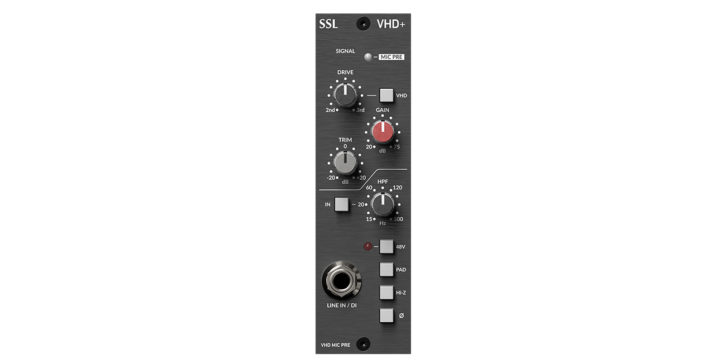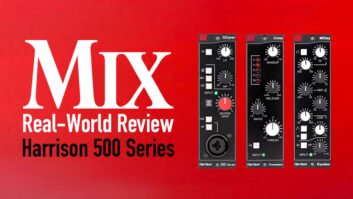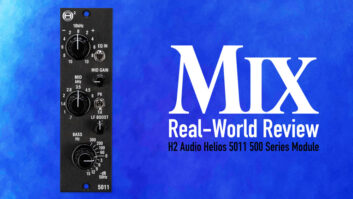
My favorite part of tracking a band is matching my collection of mic pres to my carefully curated mics for euphonic results, and 500-series mic amps have made this fascination more affordable and convenient. The newest addition to my 500 rig is the VHD Pre from SSL and it has affordably given me that classic SSL sound, along with a number of creative options.
Out of the Box
Occupying only one 500-slot, the VHD Pre packs in plenty of features without feeling too cramped or crowded. It starts with a gain control ranging from +20 to a whopping +75 dB of gain—enough to amplify quiet sources and passive ribbons. There is an input pad of -20 dB, which is enough to accept hot mics and line level sources, as well as a defeatable -18 dB/octave high-pass filter that ranges from a nearly-subsonic 15 Hz up to a truly-midrange 500 Hz for anything from rumble removal to a complete removal of all bass.
You’ll find the requisite phantom power and polarity switches, but most important is SSL’s VHD (Variable Harmonic Drive) circuit as taken from the Duality line of consoles (which actually have two sets of preamps—VHD and SuperAnalogue, hence Duality). A switch engages the circuitry, and the Drive control allows 2nd-order, 3rd-order, or a blend of both, harmonics.
There is a 1/4” direct input for electronic instruments, along with a Hi-Z switch that changes input impedance from 1.2 K ohms to 10 K ohms for tonal and sensitivity variability. A single tri-color LED indicates signal presence with the familiar green/yellow/red scheme. Finally, an output trim control (ranges from -20 to +20 dB) is provided for dialing back level on all that high-passed VHD-goosed signal you’ve created.
Repairing Spoken-Word Recordings with iZotope Rx 8 Advanced – A Real-World Review
In the Mix
It should come as no surprise that the VHD Pre has a clean, largely neutral sound that is high on headroom, wide in frequency response and particularly sweetly defined in the top-end—the classic SSL sound if you will. Some call it “glass,” others call it “pure clean gain,” some call it “sterile,” and a few call it “thin.” I call it time-tested, versatile and familiar. On vocals, acoustic guitars, classical instruments and the like, the VHD Pre strikes a chord you’ve heard a million times and can immediately recognize. I’m not saying that this SSL tone is shockingly different, just simply that the numerous subtleties add up to create something very familiar and even nostalgic.

Let’s quickly cover the FAQs before getting to the VHD details: The gain is clean all the way to +75 (there is no sudden jump in noise or distortion at end of travel); the HPF is accurate, smooth and musical (ranging up to 500 Hz is brilliant for committing to wildly filtered sounds); the switchable impedance is a “must have” if you like to tweak your tones on the way-in without EQ (10 Kohms gives you more of that SSL air); and the output trim is essential to have for precise level setting and attenuating an overdriven circuit.
The VHD section is a little tricky, and solving its mysteries is the key-to-the-kingdom. VHD is simply on or off; you can’t select the “amount” of it (not directly, at least), although the knob controls the blend of second- and third-order harmonics. Fully second-order multiples yield a warmer, congealing tone that is dark-ish, smooth, sort of scratchy and “tubey,” while fully third-order is a bit crispier, more sizzly, fuzzy and more transistor-like. Both are quite subtle without a lot of signal, although rather useful for their subtlety, especially when blended.
If you hone-in on today’s pop music, you’ll notice subtle saturation on almost any kind of track—vocals, keys, basses, drums, even handclaps—and the VHD Pre delivers those tones all day long. I found VHD often working best at juicing up detail and immediacy without being obvious or even noticeable (until bypassed, at least). Unruly tambourines, anemic vocals, boring bass, stock synths and “meh” guitars all take the heat well. I almost always had a 60/40 or a 40/60 harmonic blend, and you might be surprised how often 3rd-order is useful.
With ample gain, VHD jumps into distortion and you have to contain it deliberately for musical results. The key here is to carefully balance input gain with output trim, driving the input just hard enough to get the dirt/grit that you do want, re-balancing the odds and evens in the VHD, tweaking the HPF (maybe even the impedance) and then attenuating output until you’ve got that elusively desirable gritty growl that is manageable and sounds cool. Don’t be surprised if you find heavy VHD best combined with clean signal in parallel. All things considered, VHD really does the trick for harmonic dusting and moderate grit, but heavy distortion and manglings are more hit or miss. Basses and electronic drums? Oh yeah! Vocals? Not so much.
The Final Mix
At $579 (street), I couldn’t resist getting a VHD Pre for that widely popular vocal sound it so easily achieves. The versatility of the HPF and the variable impedance have made it an easy pre to plug-in when I’m not sure what a client is going to deliver. And now that I’ve mastered the use of this VHD section, it looks like I’ll be needing another one, so my stereo keys and other dual-input sources can get the benefit of a little SSL harmonic massaging, too.
Solid State Logic • www.solidstatelogic.com







